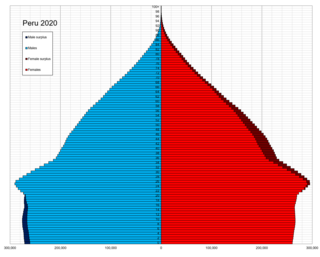
This is a demography of the population of Peru including population density, ethnicity, education level, the health of the populace, economic status, religious affiliations and other aspects of the population.

Lima, originally founded as Ciudad de Los Reyes, is the capital and largest city of Peru. It is located in the valleys of the Chillón, Rímac and Lurín Rivers, in the desert zone of the central coastal part of the country, overlooking the Pacific Ocean. Together with the seaside city of Callao, it forms a contiguous urban area known as the Lima Metropolitan Area. With a population of more than 9.7 million in its urban area and more than 11 million in its metropolitan area, Lima is one of the largest cities in the Americas.

Peru, officially the Republic of Peru, is a country in western South America. It is bordered in the north by Ecuador and Colombia, in the east by Brazil, in the southeast by Bolivia, in the south by Chile, and in the south and west by the Pacific Ocean. Peru is a megadiverse country with habitats ranging from the arid plains of the Pacific coastal region in the west to the peaks of the Andes mountains extending from the north to the southeast of the country to the tropical Amazon basin rainforest in the east with the Amazon River. Peru has a population of over 34 million, and its capital and largest city is Lima. At 1,285,216 km2, Peru is the 19th largest country in the world, and the third largest in South America.

The Viceroyalty of Peru officially known as the Kingdom of Peru was a Spanish imperial provincial administrative district, created in 1542, that originally contained modern-day Peru and most of the Spanish Empire in South America, governed from the capital of Lima. Peru was one of the two Spanish Viceroyalties in the Americas from the sixteenth to the eighteenth centuries.

Callao is a Peruvian seaside city and region on the Pacific Ocean in the Lima metropolitan area. Callao is Peru's chief seaport and home to its main airport, Jorge Chávez International Airport. Callao municipality consists of the whole Callao Region, which is also coterminous with the Province of Callao. Founded in 1537 by the Spaniards, the city has a long naval history as one of the main ports in Latin America and the Pacific, as it was one of vital Spanish towns during the colonial era. Central Callao is about 15 km (9.3 mi) west of the Historic Centre of Lima.

The administrative divisions of Peru have changed from time to time since the nation gained independence from Spain in the early 19th century. The old territorial subdivisions have split or merged due to several reasons, the most common ones being the need for decentralization and population increase, especially in Lima.

Lima Province is located in the central coast of Peru and is the only province in the country not belonging to any of the twenty-five regions. Its capital is Lima, which is also the nation's capital.
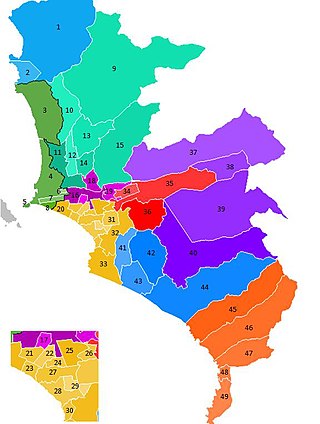
The Lima Metropolitan Area is an area formed by the conurbation of the Peruvian provinces of Lima and Callao. It is the largest of the metropolitan areas of Peru, the seventh largest in the Americas, the fourth largest in Latin America, and among the thirty largest in the world. The conurbation process started to be evident in the 1980s.
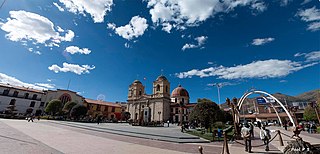
Huancayo is the capital of Junín Region, in the central highlands of Peru.

Ancón is a district of northern Lima Province in Peru. It is the popular beach resort of Lima that is visited every summer by millions of people from Lima. Is the largest district of the Lima Province.
The 2005 Peru Census was a detailed enumeration of the Peruvian population. It was conducted by the Instituto Nacional de Estadística e Informática from July 18 through August 20, 2005. Its full name in Spanish is X Censo de Población y V de Vivienda. The previous census performed in Peru was the 1993 Census. The following census was the 2007 Census.
Tapacarí, Thapa Qhari is a town and the capital of Tapacarí Province in Cochabamba Department, Bolivia. It is located at an elevation of 2,997 m. At the time of census 2001 it had a population of 411. Most of the population lives either in adjacent rural areas or in the city of Cochabamba and they only occupy local dwellings during carnival or other festivals, or on business trips.
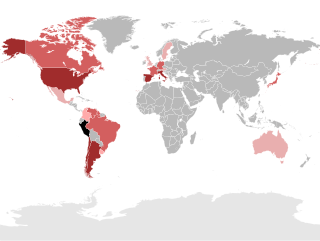
Peruvians are the citizens of Peru. What is now Peru has been inhabited for several millennia by cultures such as the Caral before the Spanish conquest in the 16th century. Peruvian population decreased from an estimated 5–9 million in the 1520s to around 600,000 in 1620 mainly because of infectious diseases carried by the Spanish. Spaniards and Africans arrived in large numbers in 1532 under colonial rule, mixing widely with each other and with Native Peruvians. During the Republic, there has been a gradual immigration of European people. Chinese and Japanese arrived in large numbers at the end of the 19th century.

According to the Organic Law of Regional Governments, the regions are, with the departments, the first-level administrative subdivisions of Peru. Since its 1821 independence, Peru had been divided into departments but faced the problem of increasing centralization of political and economic power in its capital, Lima.
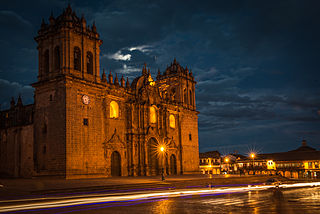
Christianity is the largest religion in Peru, with Roman Catholics having the most adherents. Religion in Peru is traditionally related to religious syncretism originating from Catholicism with the ancient Inca religion after the Spanish Conquest. However, Protestant churches of various denominations have developed considerably in the popular sectors over the past 30 years. There has been a slow but consistent advance of irreligion especially among young people in urban areas. Religions such as Judaism and Buddhism, and more recently Hinduism and Islam, are present due to immigration.

The history of Lima, the capital of Peru, began with its foundation by Francisco Pizarro on January 18, 1535. The city was established on the valley of the Rímac River in an area populated by the Ichma polity. It became the capital of the Viceroyalty of Peru and site of a Real Audiencia in 1543. In the 17th century, the city prospered as the center of an extensive trade network despite damage from earthquakes and the threat of pirates. However, prosperity came to an end in the 18th century due to an economic downturn and the Bourbon Reforms.

The Lima culture was an indigenous civilization which existed in modern-day Lima, Peru during the Early Intermediate Period, extending from roughly 100 to 650. This pre-Incan culture, which overlaps with surrounding Paracas, Moche, and Nasca civilizations, was located in the desert coastal strip of Peru in the Chillon, Rimac and Lurin River valleys. It can be difficult to differentiate the Lima culture from surrounding cultures due to both its physical proximity to other, and better documented cultures, in Coastal Peru, and because it is chronologically very close, if not over lapped, by these other cultures as well. These factors all help contribute to the obscurity of the Lima culture, of which much information is still left to be learned.
The following is a timeline of the history of the city of Lima, Peru.

Squatting in Peru is the occupation of unused or derelict buildings or land without the permission of the owner. From the 1940s onwards, land invasions created shanty towns which were first called barriadas and later pueblos jóvenes. They were initially repressed, then the government decided upon toleration and by 1998 it was estimated 2.5 million inhabitants were living in this way in the capital Lima. There are also slum tenements in the centre known as solares or tugurios, and a Wall of Shame has been built to separate rich and poor areas of the city. During the COVID-19 pandemic, an increase in the occupation of UNESCO World Heritage Sites such as Caral and the Nazca Lines was reported.





















